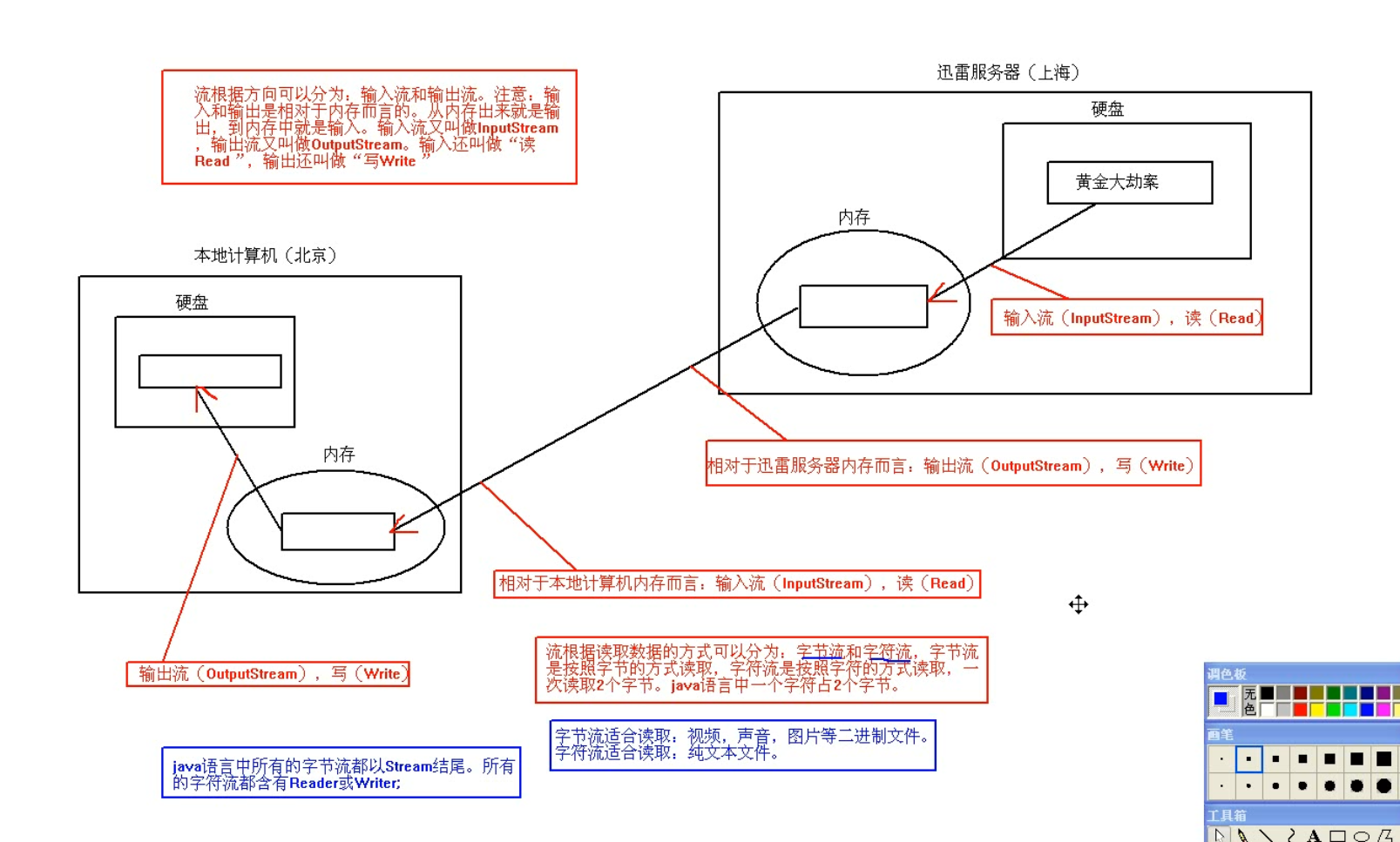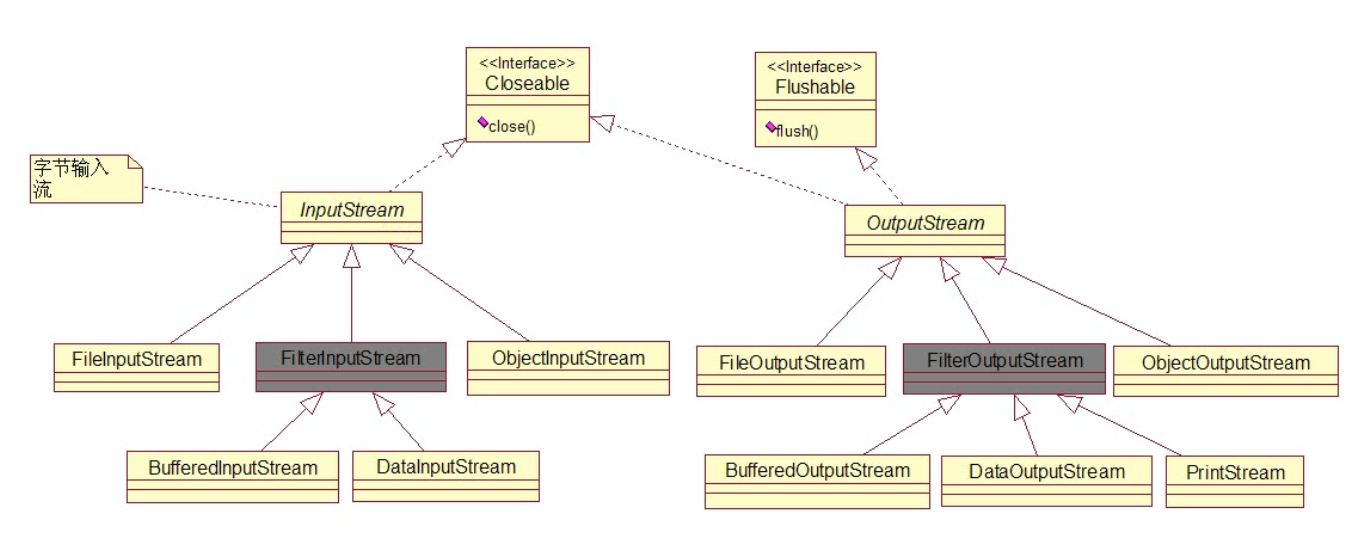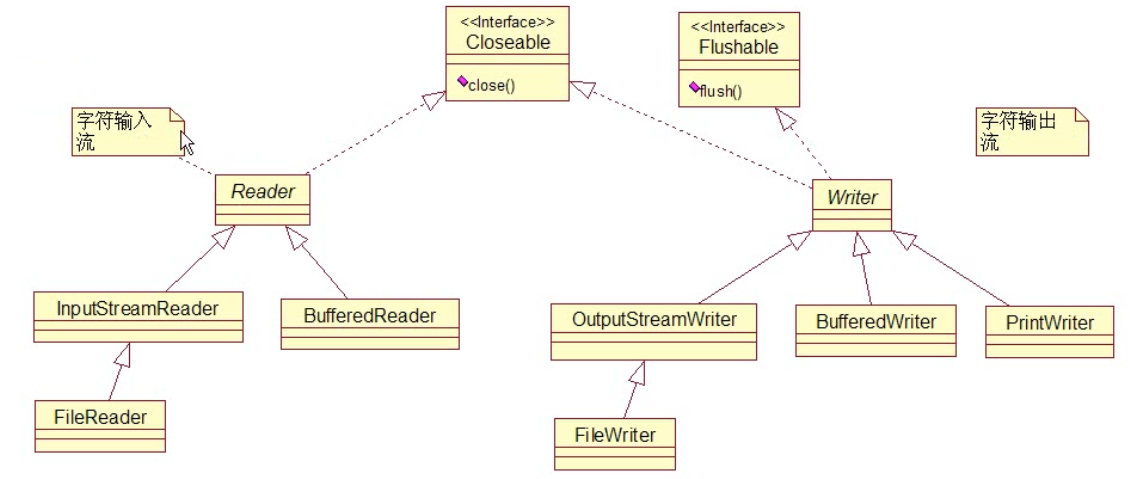Java 的 IO 流与文件
画图分析流的本质
什么是 IO 流?
文件通常是由一连串的字节或字符构成。
- 组成文件的字节序列称为字节流
- 组成文件的字符序列称为字符流
Java 中根据流的方向可以分为输入流和输出流。
- 输入流是将文件或其它输入设备的数据加载到内存的过程
- 输出流是将内存中的数据保存到文件或其他输出设备
flowchart LR
A【输入流】
B【输出流】
C【字节输入流】
D【字符输入流】
E【字节输出流】
F【字符输出流】
G[InputStream]
H[Reader]
I[OutputStream]
J[Writer]
A --- C --- G
A --- D --- H
B --- E --- I
B --- F --- J
UML 表示 Input_OutputStream 的继承结构图
UML 表示 Reader 和 Writer 的继承结构图
需要重点掌握的 16 个流
FileInputStreamFileOutputStreamFileReaderFileWriterBufferedReaderBufferedWriterBufferedInputStreamBufferedOutputStreamDataInputStreamDataOutputStreamObjectInputStreamObjectOutputStream
转换流(字节流转换成字符流)
InputStreamReaderOutputStreamReaderPrintWriterPrintStream//标准的输出流(默认输出到控制台)
InputStream (字节输入流)
InputStream 是字节输入流,InputStream 是一个抽象类,所有继承了 InputStream 的类都是字节输入流。
FileInputStream
按照字节方式读取文件。
1
2
3
4
5
6
7
8
9
10
11
12
13
14
15
16
17
18
19
20
21
22
23
24
25
26
27
28
29
30
31
32
33
34
35
36
37
38
39
40
41
42
43
44
45
46
47
48
public class FIleInputStreamTest01 {
public static void main(String[] args) {
FileInputStream file = null;
//1. 要读取某文件,先与这个文件创建一个输入流
//文件路径
String filePath = "";//相对路径,相对当前而言,在当前路径下找
String filePath1 = "D:\\005_Documents\\DailyShit.txt";//绝对路径
try {
file = new FileInputStream(filePath1);
//.开始读
int i1 = file.read(); //以字节方式读取
int i2 = file.read();
int i3 = file.read();
int i4 = file.read();
int i5 = file.read();
int i6 = file.read();
int i7 = file.read();
System.out.println(i1); //97
System.out.println(i2); //98
System.out.println(i3); //99
System.out.println(i4); //100
System.out.println(i5); //101
System.out.println(i6); //102
System.out.println(i7); //-1 //如果已经读取到文件的末尾,就会返回-1
} catch (FileNotFoundException e) {
e.printStackTrace();
} catch (IOException e) {
e.printStackTrace();
}
//为了保证流一定会释放,所以在 finally 语句块中执行
finally {
if (file != null) {
try {
file.close();
} catch (IOException e) {
e.printStackTrace();
}
}
}
}
}
以下程序存在缺点,频繁访问磁盘,伤害磁盘,并且效率低。
1
2
3
4
5
6
7
8
9
10
11
12
13
14
15
16
17
18
19
20
21
22
public class FileInputStreamTest02 {
public static void main(String[] args) throws Exception {
//1. 创建流
FileInputStream file = new FileInputStream("D:\\005_Documents\\DailyShit.txt");
//2. 开始读
while (true) {
int temp = file.read();
if(temp==-1) break;
System.out.println(temp);
}
//升级循环
int temp = 0;
while ((temp = file.read()) != -1) {
System.out.println(temp);
}
//3. 关闭
file.close();
}
}
int read (byte[] bytes);
读取之前在内存中准备一个 byte 数组,每次读取多个字节存储到 byte 数组中
一次读取多个字节,不是单字节读取了,效率高
1
2
3
4
5
6
7
8
9
10
11
12
13
14
15
16
17
18
19
20
21
22
23
24
25
26
27
28
29
30
31
public class FileInputStreamTest03 {
public static void main(String[] args) throws Exception {
//1. 创建输入流
FileInputStream file = new FileInputStream("D:\\005_Documents\\DailyShit.txt");
//2.开始读
//准备一个 byte 数组
byte[] bytes = new byte[3]; //每一次最多读取 3 个字节
//int read (byte[] bytes); 该方法返回的 int 类型的值代表的是:这次读取了多少个字节
int i1 = file.read(bytes); //3
//将 byte 数组转换成字符串
System.out.println(new String(bytes)); //abc
int i2 = file.read(bytes); //3
System.out.println(new String(bytes)); //def
int i3 = file.read(bytes); //1
System.out.println(new String(bytes)); //gef
System.out.println(new String(bytes,0,i3)); //g
int i4 = file.read(bytes); //-1 已经到达文件末尾,返回-1
System.out.println(i1);
System.out.println(i2);
System.out.println(i3);
System.out.println(i4);
//关闭
file.close();
}
}
循环读取(以下代码正式写的时候要使用 try catch,参考上面第一个代码块)
1
2
3
4
5
6
7
8
9
10
11
12
13
14
15
16
17
18
19
20
21
22
23
24
25
26
public class FileInputStreamTest04 {
public static void main(String[] args) throws Exception {
FileInputStream file = new FileInputStream("D:\\005_Documents\\DailyShit.txt");
byte[] bytes = new byte[1024]; //每次读取 1kb
while (true) {
System.out.println("=============================");
int temp = file.read(bytes);
if (temp == -1) break;
//将 byte 数组中有效的数据转换成字符串
System.out.println(new String(bytes,0,temp));
}
//升级循环
int temp = 0;
while ((temp = file.read(bytes)) != -1) {
System.out.print(new String(bytes,0,temp));
}
file.close();
}
}
available和skip方法(以下代码正式写的时候要使用 try catch,参考上面第一个代码块)
1
2
3
4
5
6
7
8
9
10
11
12
13
14
15
16
17
18
19
20
21
public class FileInputStreamTest05 {
public static void main(String[] args) throws Exception {
//1. 创建流
FileInputStream file = new FileInputStream("D:\\005_Documents\\DailyShit.txt");
System.out.println(file.available()); //7
file.read(); //97
//int available () 返回流中剩余的估计字节数
System.out.println(file.available()); //6
//跳过 2 个字节
file.skip(2);
System.out.println(file.read()); //100
//关闭
file.close();
}
}
OutputStream (字节输出流)
所有继承了 OutputStream 都是字节输出流。
FileOutputStream
java.io.OutputStream
java.io.FIleOutputStream: 文件字节输出流
将计算机内存中的数据写入硬盘文件中
1
2
3
4
5
6
7
8
9
10
11
12
13
14
15
16
17
18
19
20
21
22
23
24
25
26
27
28
29
30
31
32
33
34
35
36
37
38
public class FileOutputStreamTest01 {
public static void main(String[] args) {
//1. 创建文件字节输出流
FileOutputStream file = null;
try {
//谨慎使用,会将原文件内容覆盖
// file = new FileOutputStream("D:\\005_Documents\\temp02.txt"); //该文件不存在则自动创建
//以追加的方式写入
file = new FileOutputStream("D:\\005_Documents\\temp02.txt", true);
//2.开始写
String msg = "Hello World";
//将 String 转换成 byte 数组
byte[] bytes = msg.getBytes();
file.write(bytes);//将 byte 数组中所有的数据全部写入
//将 byte 数组的一部分写入
file.write(bytes,0,3);
//推荐最后的时候为了保证数据完全写入硬盘,所以要刷新
file.flush();
} catch (Exception e) {
e.printStackTrace();
} finally {
if (file != null) {
try {
file.close();
} catch (Exception e) {
e.printStackTrace();
}
}
}
}
}
OutputStream完成复制(以下代码正式写的时候要使用 try catch,参考上面第一个代码块)
1
2
3
4
5
6
7
8
9
10
11
12
13
14
15
16
17
18
19
20
21
22
23
24
25
26
public class Copy01 {
public static void main(String[] args) throws Exception {
//创建输入流
FileInputStream fileInputStream = new FileInputStream("D:\\005_Documents\\temp02.txt");
//创建输出流
FileOutputStream fileOutputStream = new FileOutputStream("D:\\005_Documents\\temp03.txt");
//一边读,一边写
byte[] bytes = new byte[1024];
int temp = 0;
while ((temp = fileInputStream.read(bytes)) != -1) {
//将 byte 数组中的内容直接写入
fileOutputStream.write(bytes, 0, temp);
}
//刷新
fileOutputStream.flush();
//关闭
fileInputStream.close();
fileOutputStream.close();
}
}
Reader (字符输入流)
所有继承了 Reader 都是字符输入流。
FileReader
java.io.Reader
java.io.InputStreamReader: 转换流(字节输入流转换成字符输入流)
java.io.FIleReader: 文件字符输入流
1
2
3
4
5
6
7
8
9
10
11
12
13
14
15
16
17
18
19
20
21
22
23
24
25
26
27
28
29
30
31
public class FileReaderTest01 {
public static void main(String[] args) {
//1. 创建文件字符输入流
FileReader fr = null;
try {
fr = new FileReader("D:\\005_Documents\\DailyShit.txt");
//2, 开始读
char[] chars = new char[512]; //1kb
int temp = 0;
while ((temp = fr.read(chars)) != -1) {
//将 char 数组有效部分转换成字符串
System.out.println(new String(chars, 0, temp));
}
} catch (IOException e) {
e.printStackTrace();
} finally {
if (fr != null) {
try {
fr.close();
} catch (Exception e) {
e.printStackTrace();
}
}
}
}
}
Writer (字符输出流)
所有继承了 Writer 都是字符输出流。
FileWriter
java.io.Writer
java.io.OutputStreamWriter: 转换流(字节输出流 ——> 字符输出流)
java.io.FileWriter: 文件字符输出流(以下代码正式写的时候要使用 try catch,参考上面第一个代码块)
1
2
3
4
5
6
7
8
9
10
11
12
13
14
15
16
17
18
19
20
21
22
23
public class FileWriterTest01 {
public static void main(String[] args) throws Exception {
//创建文件字符输出流
// FileWriter fw = new FileWriter("D:\\005_Documents\\temp02.txt"); //覆盖
FileWriter fw = new FileWriter("D:\\005_Documents\\temp04.txt", true); //追加
//开始写
fw.write("张学友");
//将 char 数组的一部分写入
char[] chars = {'我','是','中','国','人','!','!','?','?','?'};
fw.write(chars,0,5);
//刷新
fw.flush();
//关闭
fw.close();
}
}
完成复制
只能复制纯文本文件(以下代码正式写的时候要使用 try catch,参考上面第一个代码块)
1
2
3
4
5
6
7
8
9
10
11
12
13
14
15
16
17
18
19
public class Copy02 {
public static void main(String[] args) throws Exception {
FileReader fr = new FileReader("D:\\005_Documents\\temp04.txt");
FileWriter fw = new FileWriter("D:\\005_Documents\\temp05.txt");
char[] chars = new char[512];
int temp = 0;
while ((temp = fr.read(chars)) != -1) {
//写
fw.write(chars, 0, temp);
}
fw.flush();
fr.close();
fw.close();
}
}
BufferedInputStream BufferedOutputStream BufferedReader BufferedWriter
字节
BufferedInputStream BufferedOutputStream
字符
BufferedReader BufferedWriter 带有缓冲区的字符输入、输出流
1
2
3
4
5
6
7
8
9
10
11
12
13
14
15
16
17
18
19
20
21
22
23
24
25
public class BufferedReaderTest01 {
public static void main(String[] args) throws Exception {
//创建一个带有缓冲区的字符输入流
FileReader fr = new FileReader("D:\\005_Documents\\DailyShit.txt");//创建一个文件字符输入流
BufferedReader br = new BufferedReader(fr);//将文件字符输入流包装成带有缓冲区的字符输入流
//根据流出现的位置,流又可以分为:包装流或者处理流和节点流
//FileReader fr 是一个节点流
//BufferedReader br 是一个包装流,或者处理流
//把上面的写成一句话
BufferedReader br = new BufferedReader(new FileReader("D:\\005_Documents\\DailyShit.txt"));
//开始读
String temp = null;
while ((temp = br.readLine()) != null) { //br.readLine()方法读取一行,但是行尾不带换行符
System.out.print(temp);//输出一行
}
//关闭
//注意:关闭的时候住需要关闭最外层的包装流,(这里有一个装饰者模式)
br.close();
}
}
1
2
3
4
5
6
7
8
9
10
11
12
13
14
15
16
17
18
19
20
21
22
public class BufferedReaderTest02 {
public static void main(String[] args) throws Exception {
//创建带有缓冲区的字符输入流
FileInputStream fis = new FileInputStream("D:\\005_Documents\\DailyShit.txt");
//转换流
InputStreamReader isr = new InputStreamReader(fis);//isr 是字符流
BufferedReader br = new BufferedReader(isr);
//将上面写成一句话
BufferedReader br = new BufferedReader(new InputStreamReader(new FileInputStream("D:\\005_Documents\\DailyShit.txt")));
//开始读
String temp = null;
while ((temp = br.readLine()) != null) {
System.out.println(temp);
}
//关闭最外层的流即可(装饰者模式)
br.close();
}
}
BufferedReader接收用户键盘输入
1
2
3
4
5
6
7
8
9
10
11
12
13
14
15
16
17
18
19
20
public class BufferedReaderTest03 {
public static void main(String[] args) throws Exception {
//以前的方式
Scanner s = new Scanner(System.in); //System.in 是一个标准的输入流,默认接收键盘的输入
//程序执行到此处停下来,等待用户的输入
String str = s.next();
System.out.println("您输入了: " + str);
//使用 BufferedReader 用来接收用户的输入
BufferedReader br = new BufferedReader(new InputStreamReader(System.in));
//接收输入(每一次都接收一行)
String temp = br.readLine();
System.out.println("您输入了: " + temp);
//关闭
br.close();
}
}
1
2
3
4
5
6
7
8
9
10
11
12
13
14
15
16
17
18
19
20
21
22
23
24
25
public class BufferedWriterTest01 {
public static void main(String[] args) throws Exception {
//创建带有缓冲区的字符输出流
BufferedWriter bw1 = new BufferedWriter(new FileWriter("D:\\005_Documents\\DailyShitTemp.txt"));
BufferedWriter bw = new BufferedWriter(
new OutputStreamWriter(
new FileOutputStream("D:\\005_Documents\\DailyShitTemp.txt", true)));
//开始写
bw.write("奥运会!");
//写入一个行分隔符
bw.newLine();
bw.write("开幕式一点都没意思!");
//刷新
bw.flush();
//关闭
bw.close();
}
}
使用BufferedReader和BufferedWriter完成复制
1
2
3
4
5
6
7
8
9
10
11
12
13
14
15
16
public class Copy03 {
public static void main(String[] args) throws Exception {
BufferedReader br = new BufferedReader(new FileReader("D:\\005_Documents\\DailyShitTemp.txt"));
BufferedWriter bw = new BufferedWriter(new FileWriter("D:\\005_Documents\\DailyShitTemp1.txt"));
String temp = null;
while ((temp = br.readLine()) != null) {
bw.write(temp);
bw.newLine();
}
bw.flush();
br.close();
bw.close();
}
}
装饰者模式详解
1
2
3
4
5
6
7
8
9
10
11
12
13
14
15
16
17
18
19
20
21
public class AA {
public void m1() {
System.out.println("A's m1 method execute!!!");
}
}
public class BB extends AA {
//重写方法,注意:在源代码的基础之上的扩展
public void m1() {
System.out.println("扩展代码 1");
super.m1();
System.out.println("扩展代码 2");
}
}
public class Test01 {
public static void main(String[] args) {
AA a = new BB();
a.m1();
}
}
以上代码有缺陷:关联程度强,致命弱点,有了继承关系,耦合度强
思考:对 FileReader 这个类的 close 方法进行扩展
- 继承 (不推荐,代码耦合度太高,不利于项目的扩展)
- 装饰者模式
1
2
3
4
5
public class FileReader {
public void close() {
System.out.println("FileReader closed");
}
}
使用BufferedReader对FileReader中的 close 方法进行扩展
- 装饰者模式中要求:装饰者中含有被装饰者的引用
- 装饰者模式中要求:装饰者和被装饰者应该实现同一个类型(接口)
1
2
3
4
5
6
7
8
9
10
11
12
13
14
15
16
17
18
19
20
21
22
23
24
25
26
27
28
29
30
31
32
33
34
35
36
37
38
39
40
41
42
43
public abstract class Reader {
public abstract void close();
}
public class FileReader extends Reader {
public void close() {
System.out.println("FileReader closed");
}
}
public class BufferedReader extends Reader { //BufferedReader 装饰者
//关联关系
Reader reader; //FileReader 就是被装饰者
//Constructor
BufferedReader(Reader reader) { //Reader reader = new FileReader(),多态
this.reader = reader;
}
public void close() {
//扩展
System.out.println("扩展代码 1");
reader.close();
System.out.println("扩展代码 2");
}
}
public class Test02 {
public static void main(String[] args) {
/*
//1. 创建被装饰者
FileReader fr = new FileReader();
//2. 创建装饰者
BufferedReader br = new BufferedReader(fr);
*/
BufferedReader br = new BufferedReader(new FileReader());
//3. 通过执行装饰者中的方法间接去执行被装饰者中的方法
br.close();
}
}
DataInputStream && DataOutputStream
java.io.DataOutputStream: 数据字节输出流
可以将内存中的int i = 10; 写入到硬盘文件中,
写进去的不是字符串,写进去的是二进制数据,带类型
1
2
3
4
5
6
7
8
9
10
11
12
13
14
15
16
17
18
19
20
21
22
23
24
25
26
27
28
29
30
31
public class DataOutputStreamTest01 {
public static void main(String[] args) throws Exception {
//创建数据字节输出流
DataOutputStream dos = new DataOutputStream(new FileOutputStream("D:\\005_Documents\\DailyShitTemp2"));
//准备数据
byte b = 10;
short s = 11;
int i = 12;
long l = 1000L;
float f = 3.2f;
double d = 2.3;
boolean flag = false;
char c = 'a';
//写
dos.write(b);
dos.write(s);
dos.write(i);
dos.writeLong(l);
dos.writeFloat(f);
dos.writeDouble(d);
dos.writeBoolean(flag);
dos.writeChar(c);
//刷新
dos.flush();
//关闭
dos.close();
}
}
1
2
3
4
5
6
7
8
9
10
11
12
13
14
15
16
17
18
19
20
21
22
23
24
25
26
27
28
29
30
31
32
33
public class DataInputStreamTest01 {
public static void main(String[] args) throws Exception {
//创建输入流
DataInputStream dis = new DataInputStream(
new FileInputStream("D:\\005_Documents\\DailyShitTemp2" +
""));
//读
//注意:要使用该流读取数据,必须提前知道该文件中数据的存储格式,顺序
//读的顺序必须和写入的顺序相同
byte b = dis.readByte();
short s = dis.readShort();
int i = dis.readInt();
long l = dis.readLong();
float f = dis.readFloat();
double d = dis.readDouble();
boolean flag = dis.readBoolean();
char c = dis.readChar();
System.out.println(b);
System.out.println(s);
System.out.println(i);
System.out.println(l);
System.out.println(f);
System.out.println(d);
System.out.println(flag);
System.out.println(c);
//关闭
dis.close();
}
}
PrintStream & PrintWriter
java.io.PrintStream: 标准的输出流,默认打印到控制台,以字节方式
java.io.PrintWriter: 以字符方式
1
2
3
4
5
6
7
8
9
10
11
12
13
14
15
16
17
18
19
20
21
22
23
24
25
26
27
28
29
public class PrintStreamTest01 {
public static void main(String[] args) throws Exception {
//默认是输出到控制台的
System.out.println("Hello World!");
PrintStream ps = System.out;
ps.println("JAVA......");
//可以改变输出方向
System.setOut(new PrintStream(
new FileOutputStream("D:\\005_Documents\\log"))); //log 日志文件
//再次输出
System.out.print("HAHA");
//通常使用上面的这种方式记录日志
//需求:记录日志,m1 方法开始执行的时间和结束的时间,记录到 log 文件中
SimpleDateFormat sdf = new SimpleDateFormat("yyyy-MM-dd:mm:ss SSS");
System.out.println("m1 方法开始执行 "+sdf.format(new Date()));
m1();
System.out.println("m1 方法执行结束 "+sdf.format(new Date()));
}
public static void m1() {
System.out.println("m1 method execute!");
}
}
ObjectInputStream ObjectOutputStream 对象的序列化
java.io.ObjectOutputStream: 序列化 JAVA 对象到硬盘 (Serial)
java.io.ObjectInputStream: 将硬盘中的数据反序列化到 JVM 内存 (DeSerial)
序列化
1
2
3
4
5
6
7
8
9
10
11
12
13
14
15
16
17
18
19
20
21
22
23
24
25
26
27
28
29
30
31
32
33
34
35
36
37
38
39
40
41
import java.io.Serializable; //该接口是一个可序列化的
//该接口没有任何方法,是一个标志化接口
//像这样的接口还有:java.lang.Cloneable;可克隆的
/*
标志接口的作用:起到标识的作用
JVM 如果看到该对象实现了某个标识接口,会对它特殊待遇
疑问:User 实现 Serializable 接口,JVM 对它的特殊待遇是什么?
*/
public class User implements Serializable {
String name;
public User(String name) {
this.name = name;
}
public String toString() {
return "User[name" + this.name + "]";
}
}
public class ObjectOutputStreamTest01 {
public static void main(String[] args) throws Exception {
//1.创建对象
User u1 = new User("刘德华");
//2.创建输出流(序列化流)(JVM 中的 java 对象状态保存到硬盘中)
ObjectOutputStream oos = new ObjectOutputStream(new FileOutputStream("D:\\005_Documents\\DailyShitTemp3))"));
//3.写
oos.writeObject(u1);
//刷新
oos.flush();
//关闭
oos.close();
}
}
反序列化
1
2
3
4
5
6
7
8
9
10
11
12
13
public class ObjectInputStreamTest01 {
public static void main(String[] args) throws Exception {
//创建反序列化流
ObjectInputStream ois = new ObjectInputStream(new FileInputStream("D:\\005_Documents\\DailyShitTemp3))"));
//反序列化
Object o = ois.readObject();
System.out.println(o);
//关闭
ois.close();
}
}
序列化版本号 serialVersionUID
1
2
3
4
5
6
7
8
9
10
11
12
13
14
15
16
17
18
19
20
21
22
23
24
25
26
public class User implements Serializable {
}
public class Test01 {
public static void main(String[] args) throws Exception {
ObjectOutputStream oos = new ObjectOutputStream(new FileOutputStream("D:\\005_Documents\\user.DBF"));
User u =new User();
oos.writeObject(u);
oos.flush();
oos.close();
}
}
//反序列化
public class Test02 {
public static void main(String[] args) throws Exception {
ObjectInputStream ois = new ObjectInputStream(new FileInputStream("D:\\005_Documents\\user.DBF"));
System.out.println(ois.readObject());
ois.close();
}
}
例 1:Test01 执行序列化完成后,删除 user.DBF 文件,此时再执行 Test02 程序,会报错
因为 User 实现了 Serializable 接口,JVM 会特殊待遇:会给该类添加一个属性,
static final long serialVersionUID = 一个值;
当 User 类更新重新编译后,该属性会变化
1
2
3
4
5
6
7
8
9
10
11
12
13
14
15
16
public class User implements Serializable {
//不让系统自动生成,自己写一个序列化版本号
static final long serialVersionUID = 1234567L;
//如果不想让该属性参加序列化,需要使用 transient 关键字修饰
transient String name;
public User(String name) {
this.name = name;
}
public String toString() {
return "User[" + this.name + "]";
}
}
File
java.io.File
- File 类和流无关,不能通过该类完成文件的读和写
- FIle 是文件和目录路径名的抽象表示形式
File 代表的是硬盘上的 Directory 和 file
1
2
3
4
5
6
7
8
9
10
11
12
13
14
15
16
17
18
19
20
21
22
23
24
25
26
27
28
29
public class Test01 {
public static void main(String[] args) throws Exception {
//path 相对路径
File f1 = new File("Test01.java");
File f2 = new File("D:\\005_Documents\\user.DBF");
File f3 = new File("D:\\005_Documents");
System.out.println(f1.exists());
System.out.println(f2.exists());
System.out.println(f3.exists());
File f4 = new File("D:\\005_Documents\\123");
System.out.println(f4);
//如果不存在创建
if (!f4.exists()) {
//创建目录
f4.mkdir();
//创建文件
f4.createNewFile();
//创建多重目录
f4.mkdirs();
}
}
}
1
2
3
4
5
6
7
8
9
10
11
12
13
14
15
16
17
18
19
20
21
22
23
24
25
26
27
28
29
30
31
32
33
34
35
36
37
38
39
40
41
public class Test02 {
public static void main(String[] args) throws Exception {
//1. 获取绝对路径
File f1 = new File("D:\\005_Documents\\DailyShit.txt");
String absolutePath = f1.getAbsolutePath();
System.out.println(absolutePath);
//2. 获取文件名
System.out.println(f1.getName());
//3. 获取父路径
File f2 = new File("D:\\005_Documents\\DailyShit.txt");
String parentPath = f2.getParent();
System.out.println(parentPath);
//4. 判断该 File 是 Directory 还是 File
System.out.println(f1.isDirectory()); //false
System.out.println(f1.isFile()); //true
//5. 获取文件最后一次修改时间
System.out.println(f1.lastModified());
//6. 获取文件的长度 (字节数)
System.out.println(f1.length());
//7. 列出子文件
File f3 = new File("D:\\005_Documents");
File[] fs = f3.listFiles();
//遍历
for (File f: fs ) {
if (f.getAbsolutePath().endsWith(".txt")) {
System.out.println(f.getAbsolutePath());
}
}
}
}
使用递归,找出某目录下的所有子目录以及子文件
1
2
3
4
5
6
7
8
9
10
11
12
13
14
15
16
17
18
19
20
21
22
23
public class Test03 {
public static void main(String[] args) {
File f = new File("D:\\005_Documents");
//调用方法完成查找
m1(f);
}
public static void m1(File file) {
if (file.isFile()) {
return;
}
//f 有两种可能,f 可能是文件,也可能是目录
//先当作目录
File[] fs = file.listFiles();
for (File subF : fs) {
System.out.println(subF.getAbsolutePath());
m1(subF);
}
}
}



